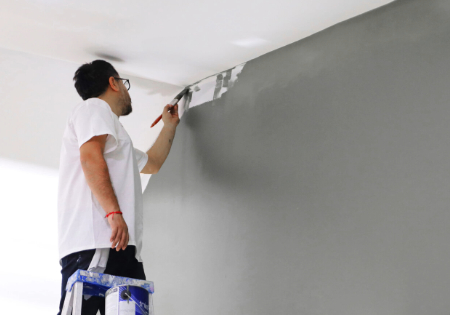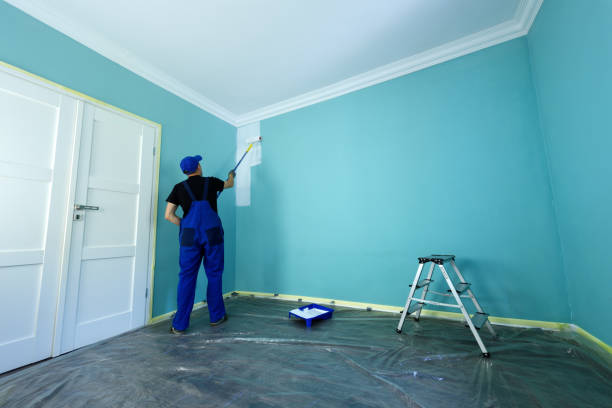Discovering the Various Kinds Of Paint: A Guide for Every Project
Exploring the numerous kinds of paint is necessary for accomplishing the preferred result in any project. From water-based options that offer convenience to oil-based paints known for their sturdiness, each option has its advantages. Specialty paints can include one-of-a-kind structures or surfaces, while environment-friendly alternatives satisfy those looking for sustainability. Comprehending these distinctions can substantially influence the success of a painting endeavor. What factors should one take into consideration when making the right selection?
Comprehending Paint Types: Oil-Based vs. water-based
Paint kinds can substantially affect a job's outcome, and recognizing the distinctions between oil-based and water-based paints is vital for informed decision-making. Water-based paints, usually described as latex paints, are made up of water as the key solvent. They dry promptly, discharge fewer unstable natural compounds (VOCs), and are very easy to clean up with soap and water. This makes them a prominent choice for interior applications and settings where air quality is a worry.
In comparison, oil-based paints utilize natural solvents, providing a long lasting, shiny finish perfect for surface areas subjected to damage, such as trim and closets. They take longer to dry, need mineral spirits for cleanup, and have a more powerful odor. benjamin moore paint store corpus christi. Choosing between these 2 types depends upon the details demands of the project, taking into consideration variables such as desired coating, application atmosphere, and simplicity of maintenance. Each kind has distinct benefits and restrictions, directing the option process
The End Up Issues: Choosing Between Matte, Satin, and Gloss
When selecting a paint finish, the selection in between matte and shiny alternatives greatly influences both aesthetic appeals and functionality. Matte surfaces offer a subtle, non-reflective appearance that can hide surface area imperfections, while glossy surfaces give toughness and ease of cleansing. Understanding the advantages and factors to consider of each can aid in making an educated decision for any kind of painting task.
Matte Complete Benefits
Although many homeowners debate the advantages of different surfaces, matte paint provides distinct benefits that make it a prominent option for both interior and outside applications. Among the main benefits of matte coating is its capability to conceal surface area imperfections, producing a smoother look on wall surfaces. This quality is particularly useful in older homes or areas with uneven surface areas. Additionally, matte paint soaks up light instead than showing it, which can enhance the visual of a room by supplying a more sophisticated and soft appearance. Furthermore, matte coatings are typically easier to retouch than glossier alternatives, as they can blend extra perfectly when used over existing paint. Overall, matte paint is an outstanding choice for those looking for a refined and sophisticated finish.
Shiny End Up Factors To Consider
A glossy coating can drastically modify the assumption of a space, providing a reflective and sleek quality that boosts both color vibrancy and light within a space. This coating is often favored for high-traffic locations and surfaces like bathroom and kitchens, where resilience and simplicity of cleaning are necessary. Nonetheless, its reflective nature can highlight imperfections on walls, making proper surface preparation important. Glossy paints also have a tendency to show spots and finger prints quicker, demanding normal maintenance. In addition, lighting plays a significant role; in brilliant environments, a glossy finish might develop glow, influencing the total visual. Cautious consideration of the certain application and setting is crucial when picking a glossy coating for any kind of task.
Specialized Paints: When to Make Use Of Textured or Chalk Paint
Specialized paints, such as distinctive and chalk paint, offer distinct visual and sensible benefits that can enhance numerous surfaces. Textured paint is ideal for developing deepness and dimension on wall surfaces, concealing imperfections while including a three-dimensional feel. It is specifically helpful in high-traffic areas where durability and aesthetic rate of interest are important.

Both kinds of specialized paints can transform rooms, yet picking the ideal one depends upon the preferred impact and surface requirements. Distinctive paint might fit bigger areas, while chalk paint can revitalize smaller products, showcasing imagination and personal design in any kind of job.
Outdoor Paints: Protecting Your Surface Areas From the Aspects
Outdoor paints are essential for safeguarding surface areas versus various weather. Comprehending their weather resistance features, correct surface preparation needs, and efficient application techniques can greatly improve sturdiness and performance. This area will outline vital considerations for picking and using exterior paints efficiently.
Weather Resistance Includes
Climate resistance is a necessary function of exterior paints, as it determines just how well surfaces can hold up against the severe components of nature. Top notch outdoor paints are created to resist damages from UV rays, moisture, and temperature variations. UV resistance guarantees shades continue to be dynamic with time, avoiding fading and staining. Moisture resistance safeguards versus mold and mildew, which can jeopardize the honesty of surfaces. Furthermore, paints with superb temperature resistance can get and expand without breaking, preserving their safety qualities. When choosing outside paints, it is important to consider these climate resistance features, as they contribute to the long life and durability of colored surfaces, making sure they continue to be aesthetically pleasing and practical in spite of direct exposure to the components.
Surface Area Prep Work Requirements
Proper surface preparation is an essential action in accomplishing the ideal outcomes with exterior paints. To assure ideal adhesion and sturdiness, surfaces have to be thoroughly cleaned, removing grease, mold, and dust. This can be achieved utilizing a stress washing machine or a scrub brush with an appropriate cleaning service. Once cleaned, surfaces ought to be examined for any peeling or flaking paint, which have to be scratched away to develop a smooth foundation. Repairing any openings or fractures is also important, as these can allow moisture seepage. Furthermore, sanding rough look at here areas advertises much better paint bond. Finally, using a guide fit for outdoor usage can improve the paint's performance, guaranteeing a long-lasting coating that stands up to the elements. Correct preparation is key to an effective outdoor paint project.
Application Strategies Tips
While applying exterior paints, it is crucial to utilize effective methods that guarantee surface areas are well-protected versus the elements. Initially, choose the appropriate day for paint; low moisture and mild temperatures enhance attachment and drying. Prepping the surface area extensively-- cleaning, sanding, and priming-- makes certain better paint adhesion and toughness. Utilizing high-grade brushes or rollers can give a smoother surface, while spray painting might cover large locations successfully. Using paint in thin, also coats avoids runs and drips. It is a good idea to adhere to maker instructions relating to drying times in between coats. Ultimately, verify appropriate air flow throughout application to facilitate drying and decrease direct exposure to fumes. These techniques substantially boost the longevity and performance of outdoor paint.
Eco-Friendly Options: Low-VOC and Zero-VOC Paints
As consumers come to be significantly conscious of the ecological effect of their selections, low-VOC and zero-VOC paints have arised as popular choices. These paints are formulated to consist of fewer unpredictable natural substances (VOCs), which are chemicals that can vaporize into the air and add to air pollution and illness. Low-VOC paints generally have a restricted quantity of VOCs, while zero-VOC paints have minimal levels, making them more secure for both exterior and indoor usage.
The advantages of making use of low-VOC and zero-VOC paints extend past ecological considerations; they likewise enhance interior air quality, minimizing the risk of breathing problems and sensitive reactions. Several makers now offer a variety of colors and coatings in green options, making it simpler for customers to locate ideal items for their jobs. By selecting these paints, individuals can contribute to a healthier atmosphere while still attaining the visual they desire in their areas.
Devices and Methods for a Flawless Application
Achieving a perfect paint application calls for navigate here the right devices and strategies, which can greatly boost the outcome. Picking the appropriate brush or roller is vital; brushes work well for sides and elaborate locations, while rollers cover larger surfaces efficiently. Using top notch materials guarantees better paint distribution and lessens touches. For excellent results, surface preparation is crucial. This consists of cleaning, fining sand, and priming surface areas to advertise bond.
Strategy likewise plays a significant duty. The "W" approach with a roller aids to equally disperse paint, while long, smooth strokes with a brush avoid noticeable lines. Operating in sections enables much better control and blending. Additionally, applying slim layers is better to thick layers, decreasing the danger of drips and irregular appearances. Maintaining a damp edge throughout application helps attain seamless modifications between locations. By integrating these devices and methods, one can attain a polished and expert coating.
Tips for Maintaining and Caring for Your Painted Surfaces
Appropriate upkeep and treatment of painted surface areas can considerably expand their life-span and protect their look. Routine cleaning is vital; making use of a soft towel or sponge with light soap and water can remove dirt and dirt without damaging the paint. It is a good idea to stay clear of unpleasant cleansers or rubbing pads, as these can scratch the surface. Additionally, using a fresh layer of paint every couple of years can secure and invigorate the color against wear.
For outdoor surface areas, evaluating for indicators of peeling off or fading consistently is essential. Without delay addressing any problems protects against additional damage. In areas vulnerable to dampness, such as shower rooms, utilizing mold-resistant paint and guaranteeing proper air flow can assist maintain the honesty of the paint. Lastly, utilizing safety surfaces can shield versus UV rays and stains, ensuring that repainted surfaces continue to be enticing and dynamic for years to find, ultimately boosting the overall visual of the space.
Frequently Asked Questions
Can I Mix Different Kind Of Paint With Each Other?
Blending various kinds of paint is typically not recommended, as it can lead to issues like inadequate attachment, irregular structure, or unforeseen chain reaction. It's ideal to utilize compatible paints for optimal results and toughness.

Just how Do I Properly Store Extra Paint?
To effectively store leftover paint, seal the container snugly, tag it with the date and color, and keep it in a great, completely dry place away from direct sunshine and severe temperature levels for perfect preservation.
What Is the Finest Means to Dispose of Unused Paint?
The very best method to throw away extra paint is to check local policies, as lots of locations have actually marked hazardous waste facilities. Take into consideration giving away functional paint to neighborhood organizations or institutions for their jobs.
Exactly How Can I Tell if Paint Is Still Good to Use?
To read what he said determine if paint is still excellent, analyze its shade, consistency, and smell. If it shows up separated, has an unpleasant odor, or shows substantial modifications in texture, it's most likely no more functional.
Are There Age Restrictions for Acquiring Paint Products?
In several regions, there are no specific age constraints for acquiring paint products. Some stores may need customers to be at least 18 years old, especially for items containing solvents or hazardous products.
Paint kinds can noticeably affect a project's outcome, and comprehending the differences in between oil-based and water-based paints is crucial for notified decision-making. Water-based paints, usually referred to as latex paints, are composed of water as the primary solvent. In comparison, oil-based paints make use of organic solvents, providing a sturdy, shiny coating suitable for surfaces subjected to use and tear, such as trim and cabinets. Specialized paints, such as distinctive and chalk paint, offer distinct visual and functional benefits that can boost different surface areas. In areas susceptible to wetness, such as restrooms, making use of mold-resistant paint and ensuring proper air flow can aid keep the integrity of the paint.